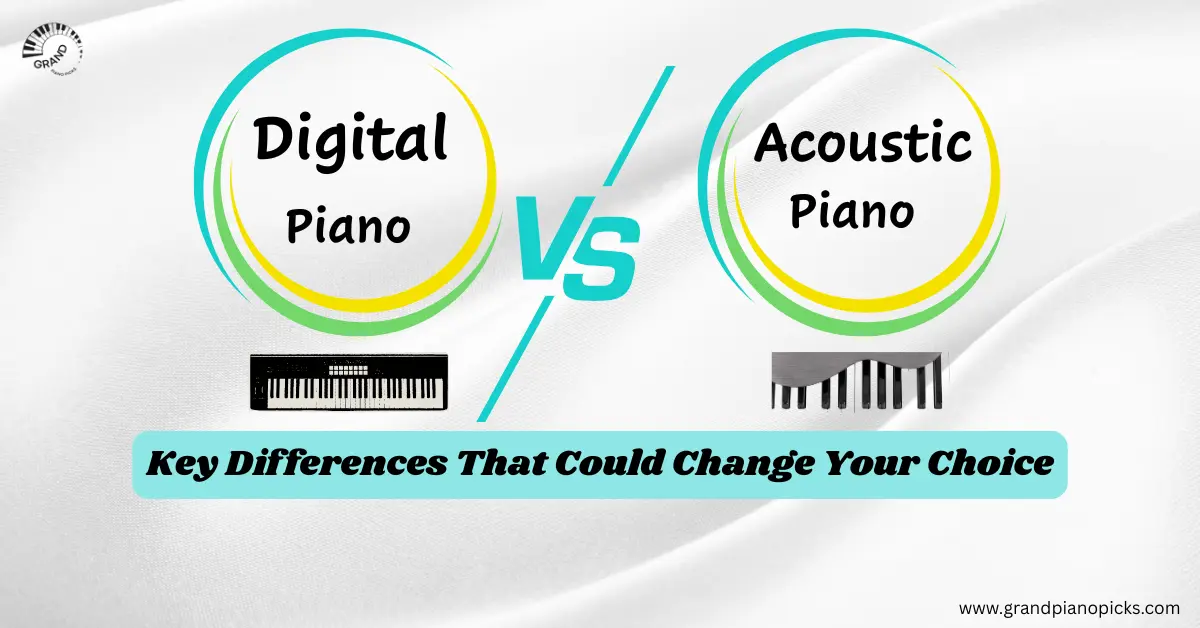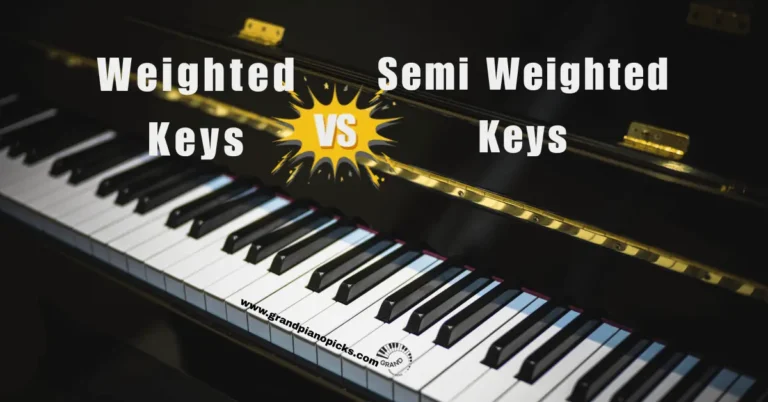Digital Piano vs Acoustic Piano: Key Differences You Should Know
Whether you are a seasoned pianist or a professional looking for a perfect instrument to explore your musical journey, choosing the right one will give you real joy. When there are many options available for a digital piano or an acoustic piano, you may be overwhelmed.
“Digital Piano vs Acoustic Piano” means key differences between both. Both pianos have their unique charm, beauty, salient features, and limitations. All the features make them different, with some advanced skills and benefits.
Digital pianos can be made with the action of a real acoustic piano. The weighted keys can be used to make a sound like a real piano. Sometimes the player wants an instrument, either a digital piano or a real piano, but he cannot afford the budget or has some issues.
So the player needs complete instruction to buy a real one according to his budget, interest, and needs. He should know all the important features of the instruments.
In this article, we will explore the key differences between a digital piano vs acoustic piano. The types, benefits, salient features, which one is better to choose, and the conditions required for selection will all be discussed.
This guide will help beginners, intermediate players, and seasoned pianists explore their musical journey and make it adventurous.
What is a Digital Piano?
A digital piano is an instrument that simulates the sound of a real acoustic piano. It uses sampling technology to provide better functionality. It uses weighted keys that act with the hammer. The hammer turns to the strings and strikes back at them. Then a pressure with weight and some resistance activates the strings.
The digital pianos come with various built-in functions like connection with USB, Bluetooth, electronic devices, and a MIDI and recording system. Whether beginners or professional players use it for learning music education.
Types of Digital Pianos
There are four main types of digital pianos. They provide many benefits to their players.
1. Portable Digital Pianos
Another name used for portable pianos is “slab pianos.” As the name suggests, they are used for mobility. They do not have a stand or a cabinet. They are lightweight and easy to move. They provide 88 weighted keys to feel like a real piano.
Their benefit is that the pianist can easily move it when going for any performances. The only feature that they do not provide is a cabinet for storage.
Portability brings compactness while using digital pianos. If you want something like an acoustic piano with portability issues resolved, we have reviewed the 5 Best Portable Digital Piano with Weighted Keys. Perfect for players of all skill levels.
2. Console Digital Pianos
Console digital pianos not only replicate the sound but also feature the look of a real acoustic piano. It is designed in a more beautiful pattern with a furniture style. It gives a furnished look. It offers better sound quality and touch results.
It is often used as a decorative piece in homes. It provides the overall best piano experience. Its uses are in homes for decoration and learning. As it is bulky, it is less portable.
3. Stage Digital Pianos
Stage digital pianos are designed for stage performances. They offer a better quality of sound, shaping ideas for sound and connection systems. It is used for live performances and recordings. They provide a long period of durability.
The only thing that it lacks is speakers for high-quality sound.
4. Hybrid Digital Pianos
These digital pianos use real technology to look like an acoustic piano. They are made up of wooden cabinets. They offer high-end sound amplification. They use real hammers to generate sound. For very serious pianists, the hybrid digital pianos are recommended. They are too heavy to move.
They are more expensive than the other types of digital pianos.
What is an Acoustic Piano?
An acoustic piano is also known as a real piano. An acoustic piano is a traditional instrument that mimics the sound with the most advanced features and styles. It uses hammers that hit the strings, and a realistic experience of playing is achieved.
To achieve this experience, the other pianos can be made like acoustic pianos. The digital pianos are made like real pianos with the use of weighted keys. But the only resonant and real sound is produced by real pianos.
When comparing the digital piano vs the acoustic piano sound, the acoustic piano comes out on top. When the hammer hits the strings, the strings use a soundboard to amplify the finer tones. The richness in the sound is the most salient feature provided by the acoustic pianos.
Types of Acoustic Pianos
When discussing the digital piano vs acoustic piano, acoustic pianos come in two main types. Both are discussed.
1. Grand Pianos
Grand pianos are known for their large size and horizontal shape. They use a soundboard, hammer, strings, keys, and pedals to mimic the sound dynamically. Grand pianos produce much finer tones and craftsmanship with artistic vision.
Grand pianos further fall into three main categories.
Concert Grand Piano: Concert Grand pianos are used in concert halls for performances. Their height is about 8 feet 9 inches or above. They provide an elegant sound.
Semi-concert Piano: The semi-concert grand piano is also known as the parlor grand piano. Semi-concert pianos are a bit smaller than the concert grand pianos. They are ideal for home use.
Baby Grand Piano: The baby grand piano is smaller in size. Its height is from 4 to 5 feet. It is the best option for beginners and small studios and spaces.
2. Upright Piano
Upright pianos are vertical in shape. They are small in size. They do not create space issues. They are space-saving and affordable. In upright pianos, the strings and soundboard are forced into a vertical position.
The upright pianos further fall into four main types.
Professional Upright: Professional uprights are space-saving. They are the closing pianos for baby grand pianos.
Studio Upright: It is a common upright piano that is used by music teachers in schools and studios.
Console Upright: Console upright pianos have a luxurious look. They are best for homes.
Spinet Upright: An upright spinet piano is not a great investment. It is smaller in size. Provide low-quality sound.
Digital Piano vs Acoustic Piano: Key Difference
| Features | Digital Pianos | Acoustic Pianos |
| Definition | Digital pianos mimic the feel of a real acoustic piano using hammer action and weighted keys. | Acoustic pianos are designed in such a way that they don’t need any additional mechanics to generate a real, elegant sound. They can produce. |
| Types | Digital pianos have four main types: portable, console, stage, and hybrid digital pianos. | Acoustic pianos come in two types: grand pianos and upright pianos. |
| Sound Quality | Digital pianos use techniques of a real piano, but they cannot generate the same sound. Somehow, it lacks uniqueness. | Acoustic pianos generate high-amplifying sound, the same as natural resonance. |
| Touch Sensitivity | In digital pianos, when the keys are pressed harder, a louder sound is produced. When the keys are pressed lower, the lower sound is produced. | In acoustic pianos, the touch response is different. The lower the keys, the heavier the sound, and the heavier the keys, the lower the sound that is produced. |
| Portability | Digital pianos are lightweight and provide ease of movement. | Acoustic pianos are heavier when compared to digital pianos. Very difficult to move. |
| Sound Range | Digital pianos offer a lot of sounds, providing multiple features like USB and computer connections and headphone jacks. | Acoustic pianos provide only one sound classically, with minimum features. |
| Volume Control | When using digital pianos, you can easily practice with the use of headphones to avoid any extra noise. | Acoustic pianos don’t provide any volume control. The voice is louder. |
| Durability | A digital piano’s material may become outdated. It can last 20 years. | Acoustic pianos are durable. They can last 100 years when properly cared for. |
| Affordability | Digital pianos are budget-friendly. | Acoustic pianos are very expensive. The tuning requires a lot of cost. |
Digital Piano vs Acoustic Piano: Which One Should You Choose?
Acoustic Pianos are Best if:
- You are a beginner, a student, or a traveling musician.
- Want to practice quietly with headphones.
- You can afford the budget and space.
- Want a special touch in music.
Digital Pianos are Best if:
- You are an advanced pianist.
- Want a volume control instrument.
- Seeking a budget-friendly piano.
- Looking for a moving piano.
- Want more advanced features.
Is acoustic piano better than digital piano?
Acoustic pianos are better than digital pianos in some ways. Acoustic pianos provide a natural sound without the use of any additional mechanisms. They are durable.
Is digital piano as good as real piano?
Digital pianos are good in many ways. But they cannot beat the real pianos. They produce sound with the use of weighted keys. When the hammer hits the strings, the sound is produced. This mimics the feel of acoustic pianos but is not the same as real pianos.
What are the disadvantages of a digital piano?
Digital pianos are good in many features, but they have two disadvantages. They cannot generate as natural a sound as the real pianos create. Their material is not good to support durability.






